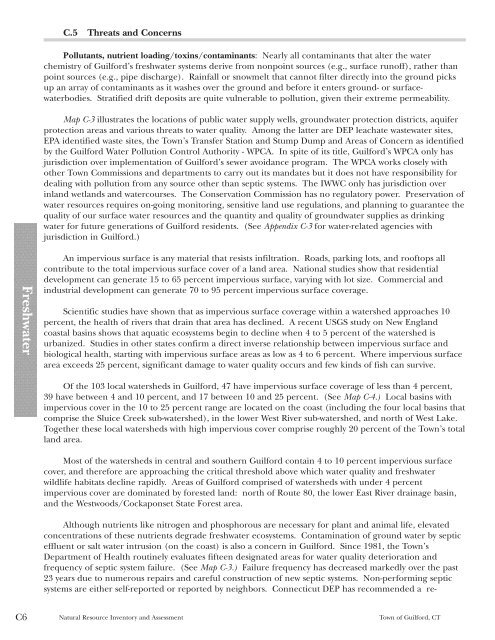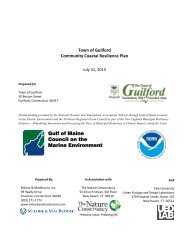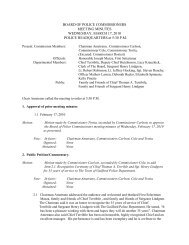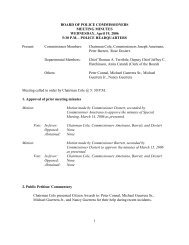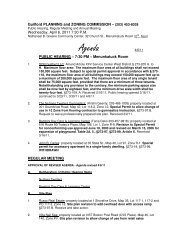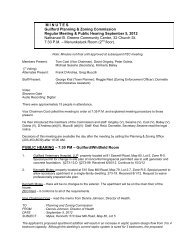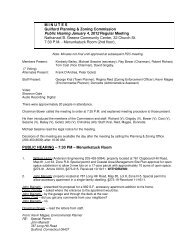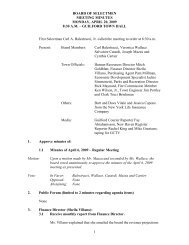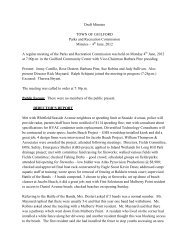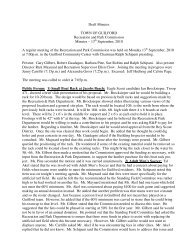Natural Resource Inventory and Assessment - Town of Guilford
Natural Resource Inventory and Assessment - Town of Guilford
Natural Resource Inventory and Assessment - Town of Guilford
You also want an ePaper? Increase the reach of your titles
YUMPU automatically turns print PDFs into web optimized ePapers that Google loves.
Freshwater<br />
C6<br />
C.5 Threats <strong>and</strong> Concerns<br />
Pollutants, nutrient loading/toxins/contaminants: Nearly all contaminants that alter the water<br />
chemistry <strong>of</strong> <strong>Guilford</strong>’s freshwater systems derive from nonpoint sources (e.g., surface run<strong>of</strong>f), rather than<br />
point sources (e.g., pipe discharge). Rainfall or snowmelt that cannot filter directly into the ground picks<br />
up an array <strong>of</strong> contaminants as it washes over the ground <strong>and</strong> before it enters ground- or surfacewaterbodies.<br />
Stratified drift deposits are quite vulnerable to pollution, given their extreme permeability.<br />
Map C-3 illustrates the locations <strong>of</strong> public water supply wells, groundwater protection districts, aquifer<br />
protection areas <strong>and</strong> various threats to water quality. Among the latter are DEP leachate wastewater sites,<br />
EPA identified waste sites, the <strong>Town</strong>’s Transfer Station <strong>and</strong> Stump Dump <strong>and</strong> Areas <strong>of</strong> Concern as identified<br />
by the <strong>Guilford</strong> Water Pollution Control Authority - WPCA. In spite <strong>of</strong> its title, <strong>Guilford</strong>’s WPCA only has<br />
jurisdiction over implementation <strong>of</strong> <strong>Guilford</strong>’s sewer avoidance program. The WPCA works closely with<br />
other <strong>Town</strong> Commissions <strong>and</strong> departments to carry out its m<strong>and</strong>ates but it does not have responsibility for<br />
dealing with pollution from any source other than septic systems. The IWWC only has jurisdiction over<br />
inl<strong>and</strong> wetl<strong>and</strong>s <strong>and</strong> watercourses. The Conservation Commission has no regulatory power. Preservation <strong>of</strong><br />
water resources requires on-going monitoring, sensitive l<strong>and</strong> use regulations, <strong>and</strong> planning to guarantee the<br />
quality <strong>of</strong> our surface water resources <strong>and</strong> the quantity <strong>and</strong> quality <strong>of</strong> groundwater supplies as drinking<br />
water for future generations <strong>of</strong> <strong>Guilford</strong> residents. (See Appendix C-3 for water-related agencies with<br />
jurisdiction in <strong>Guilford</strong>.)<br />
An impervious surface is any material that resists infiltration. Roads, parking lots, <strong>and</strong> ro<strong>of</strong>tops all<br />
contribute to the total impervious surface cover <strong>of</strong> a l<strong>and</strong> area. National studies show that residential<br />
development can generate 15 to 65 percent impervious surface, varying with lot size. Commercial <strong>and</strong><br />
industrial development can generate 70 to 95 percent impervious surface coverage.<br />
Scientific studies have shown that as impervious surface coverage within a watershed approaches 10<br />
percent, the health <strong>of</strong> rivers that drain that area has declined. A recent USGS study on New Engl<strong>and</strong><br />
coastal basins shows that aquatic ecosystems begin to decline when 4 to 5 percent <strong>of</strong> the watershed is<br />
urbanized. Studies in other states confirm a direct inverse relationship between impervious surface <strong>and</strong><br />
biological health, starting with impervious surface areas as low as 4 to 6 percent. Where impervious surface<br />
area exceeds 25 percent, significant damage to water quality occurs <strong>and</strong> few kinds <strong>of</strong> fish can survive.<br />
Of the 103 local watersheds in <strong>Guilford</strong>, 47 have impervious surface coverage <strong>of</strong> less than 4 percent,<br />
39 have between 4 <strong>and</strong> 10 percent, <strong>and</strong> 17 between 10 <strong>and</strong> 25 percent. (See Map C-4.) Local basins with<br />
impervious cover in the 10 to 25 percent range are located on the coast (including the four local basins that<br />
comprise the Sluice Creek sub-watershed), in the lower West River sub-watershed, <strong>and</strong> north <strong>of</strong> West Lake.<br />
Together these local watersheds with high impervious cover comprise roughly 20 percent <strong>of</strong> the <strong>Town</strong>’s total<br />
l<strong>and</strong> area.<br />
Most <strong>of</strong> the watersheds in central <strong>and</strong> southern <strong>Guilford</strong> contain 4 to 10 percent impervious surface<br />
cover, <strong>and</strong> therefore are approaching the critical threshold above which water quality <strong>and</strong> freshwater<br />
wildlife habitats decline rapidly. Areas <strong>of</strong> <strong>Guilford</strong> comprised <strong>of</strong> watersheds with under 4 percent<br />
impervious cover are dominated by forested l<strong>and</strong>: north <strong>of</strong> Route 80, the lower East River drainage basin,<br />
<strong>and</strong> the Westwoods/Cockaponset State Forest area.<br />
Although nutrients like nitrogen <strong>and</strong> phosphorous are necessary for plant <strong>and</strong> animal life, elevated<br />
concentrations <strong>of</strong> these nutrients degrade freshwater ecosystems. Contamination <strong>of</strong> ground water by septic<br />
effluent or salt water intrusion (on the coast) is also a concern in <strong>Guilford</strong>. Since 1981, the <strong>Town</strong>’s<br />
Department <strong>of</strong> Health routinely evaluates fifteen designated areas for water quality deterioration <strong>and</strong><br />
frequency <strong>of</strong> septic system failure. (See Map C-3.) Failure frequency has decreased markedly over the past<br />
23 years due to numerous repairs <strong>and</strong> careful construction <strong>of</strong> new septic systems. Non-performing septic<br />
systems are either self-reported or reported by neighbors. Connecticut DEP has recommended a re-<br />
<strong>Natural</strong> <strong>Resource</strong> <strong>Inventory</strong> <strong>and</strong> <strong>Assessment</strong> <strong>Town</strong> <strong>of</strong> <strong>Guilford</strong>, CT


